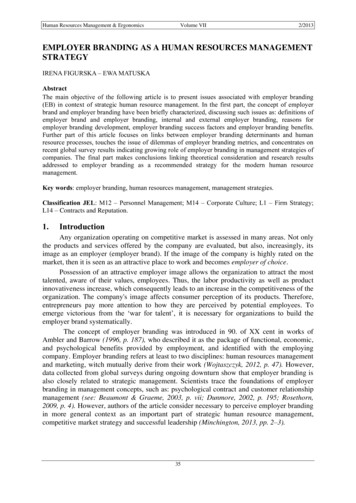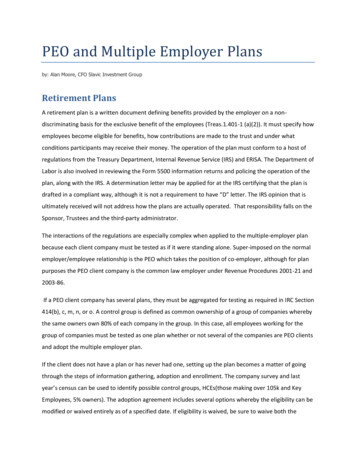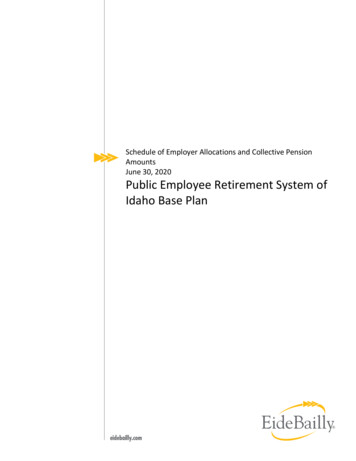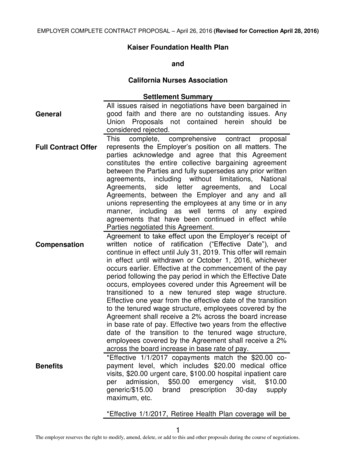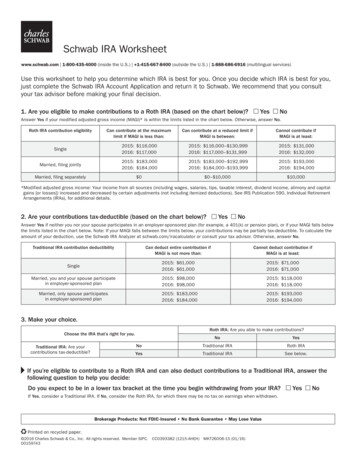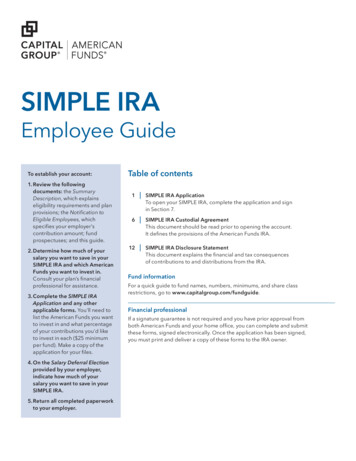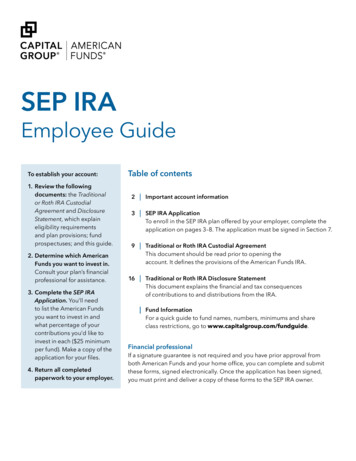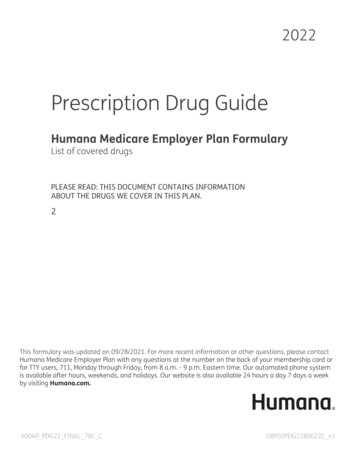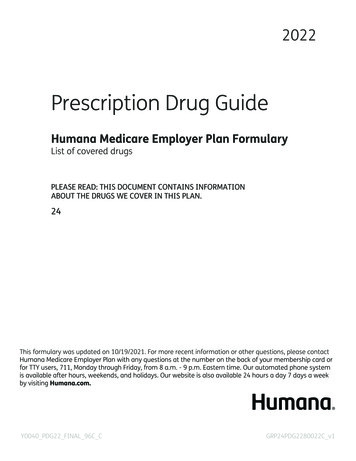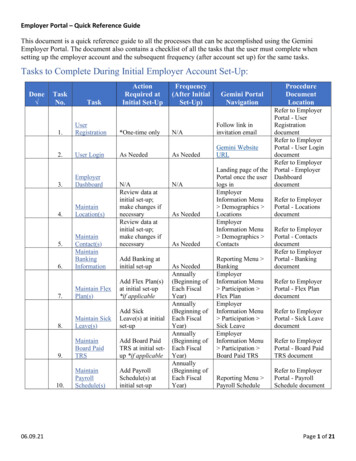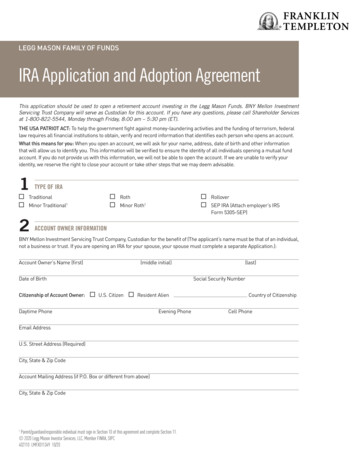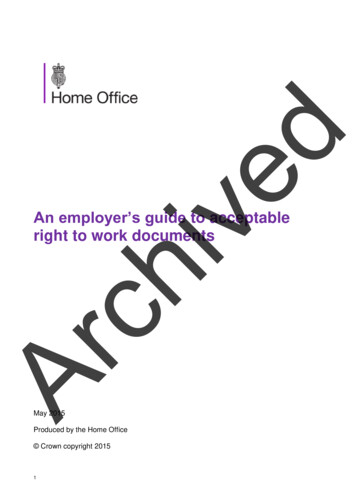
Transcription
edArchivAn employer’s guide to acceptableright to work documentsMay 2015Produced by the Home Office Crown copyright 20151
ContentsIntroduction3How should this guide by used?4How to conduct right to work checks4Step 1: Acceptable documents5Step 2: Checking the validity of documents5Step 3: Retaining evidence6Additional evidence from students7Acceptable documents for right to work checks7A8ed3Biometric Residence PermitsDesign of a Biometric Residence Permit8BResidence Cards (Biometric Format)12CCitizens of the United Kingdom and Common Travel AreaArchiv(including the right of abode)12UK Passports13UK Birth and Adoption Certificates13Certificates of Registration or Naturalisation as a British Citizen13The Common Travel Area14Right of Abode Certificates14DNationals from the European Economic Area (EEA) and their nonEEA family members14EEA (and Swiss) Nationals16Non EEA family members of EEA (and Swiss) nationals17Certificates of Application18EAsylum Claimants19FNon EEA migrants with a right to work20Immigration Status Documents21A Positive Verification Notice issued by the Home Office EmployerChecking Service24List of Documents that demonstrate a right to work2
1.IntroductionIllegal working often results in abusive and exploitative behaviour, the mistreatment ofillegal migrant workers, tax evasion and poor housing conditions. It can also undercutlegitimate businesses and have an adverse impact on the employment of people whoare lawfully in the UK.How should this guide be used?edThe law on preventing illegal working is set out in sections 15 to 25 of the Immigration,Asylum and Nationality Act 2006 (the 2006 Act). This legislation replaced section 8 ofthe Asylum and Immigration Act 1996 (the 1996 Act) in respect of employment thatcommenced on or after 29 February 2008. Under section 15 of the 2006 Act, anemployer may be liable for a civil penalty if they employ someone who does not havethe right to undertake the work in question. However, an employer may establish astatutory excuse against this liability by carrying out prescribed document checksbefore the employment starts, although this excuse is not available if the employerknows that the employment is not permitted. The check has to be repeated if theemployee only has limited permission to be in the UK.ArchivThis guide should be used by employers, including anyone in their organisation who isdelegated to conduct right to work checks, in order to become familiar with thedocuments they are checking. In this guidance we refer to employers as ‘you, and theHome Office as ‘we’.It provides information about the documents which are acceptable for you to check toestablish someone’s right to work, provides examples of these documents and anexplanation of relevant features. It also provides links to other useful sources ofinformation on documents.For guidance on how to conduct right to work checks correctly, please refer to ‘Anemployer’s guide to right to work checks’ and the online interactive tool ‘Check ifsomeone can work in the UK’ which will take you step by step through the right to workcheck.This guide has been issued alongside other guidance, Codes of practice and tools. Thiscollection comprises: An employer’s guide to the administration of the civil penalty scheme;An employer’s guide to right to work checks;Frequently asked questions;Code of practice on preventing illegal working: Civil penalty scheme foremployers;Code of practice for employers: Avoiding unlawful discrimination whilepreventing illegal working;An employers ‘Right to Work Checklist’;The online interactive tool ‘Check if someone can work in the UK’; andThe online interactive tool ‘Employer checking service enquiries”.They can be found at this link.3
How to conduct right to work checksArchivedThere are 3 basic steps to conducting a right to work check:Full guidance is provided in ‘An employer’s guide to right to work checks’.Step 1: Acceptable documentsThe documents you may accept from a person to establish their right to work are setout in regulations. There are two lists – List A and List B. They are found here. Youmust obtain an original document, or combination of documents, specified in one ofthese lists in order to comply with step 1.List A contains the range of documents which you may accept for a person who has apermanent right to work in the UK. If you conduct the right to work checks correctlybefore employment begins, you will establish a continuous statutory excuse for theduration of that person’s employment with you. You do not have to conduct any furtherchecks.List B contains a range of documents which may be accepted for a person who has atemporary right to work in the UK. If you conduct the right to work checks correctly, youwill establish a time-limited statutory excuse. You will be required to conduct a follow-upcheck in order to retain your statutory excuse. This will generally be when thepermission to be in the UK comes to an end.Step 2: Checking the validity of documentsWhen you are checking the validity of the documents, you must ensure that you do thisin the presence of the holder. This may be a physical presence in person or via a live4
video link. In both cases, you must be in the physical possession of the originaldocument or documents. You may not rely on the inspection of the document via a livevideo link or by checking a faxed or scanned copy of the document. The responsibilityfor checking the document is yours. Whilst it may be delegated to your members ofstaff, you will remain liable for the penalty. You may not delegate this responsibility to athird party.edIf you are given a false document, you will only be liable for a civil penalty if it isreasonably apparent that it is false. This means that a person who is untrained in theidentification of false documents, examining it carefully, but briefly, and without the useof technological aids could reasonably be expected to realise that the document inquestion is not genuine.You will not be able to rely on a statutory excuse if you knew that the document wasfalse, that it did not rightfully belong to the holder, or the work was not permitted.ArchivIn order to establish a statutory excuse, you are required only to conduct anexamination of the document and to check this against the holder of that document.You may, however, wish to consider using a commercially available document scannerto help check the authenticity of documents presented to you, notably passports,Biometric Residence Permits (BRPs) and Residence Cards (biometric format).Guidance about using such technology is available at this link.You may also wish to increase your understanding and ability to identify forgeddocuments through training and using publicly available sources of information. Youmay download training on recognising fraudulent identity documents here.PRADO (the Public Register of Authentic Travel and Identity Documents Online) is apublic web site run by the European Union which provides guidance on an extensiverange of passports and other travel and identity documents throughout the EuropeanUnion, including their security features.If someone gives you a false document or a genuine document that does not belong tothem or commits an offence under the Identity Documents Act 2010, you should usethis link to report the individual to us, or call our Sponsorship, Employer and EducationHelpline on 0300 123 4699, (Monday to Thursday, 9am to 5pm, Friday, 9am to4:30pm).If you do not employ the person, you have no liability for a civil penalty.Step 3: Retaining evidenceYou must keep a record of every document you have checked. This may be a hardcopyor a scanned and unalterable copy, such as a jpeg or pdf document. You should keepthe copies securely for the duration of the person’s employment and for a further twoyears after they stop working for you. By doing this, we will be able to check whetheryou have complied with the law if we find that someone is, or has been working for youillegally.You must also make a record of the date on which you conducted your check. This maybe by either making a dated declaration on the document copy or by holding a separate5
record, securely, which may be shown to us upon request to establish your statutoryexcuse.Additional evidence from studentsedThis date of check may be written on the document copy as follows: ‘the date on whichthis right to work check was made: [insert date]’, or you may make a separate manualor digital record indicating the date you conducted the check and copied thedocuments. We recommend that evidence is made easily available so that you canshow it quickly in the event that you are requested to show it to us to demonstrate thatyou have performed a right to work check and retain a statutory excuse.ArchivWhen conducting checks, if you are presented with documents indicating that theholder is a student with a limited right to work in the UK during term time, you arerequired to obtain and retain evidence of their academic term and vacation dates. See‘An employer’s guide on right to work checks’ for more detailed information on theserequirements.6
Acceptable documents for right to work checksA.Biometric Residence PermitsedBiometric Residence Permits (BRPs) are biometric immigration documents that areissued in the UK to migrants granted permission to remain in the UK for more than sixmonths. Between March and the end of July 2015, we are gradually rolling out BRPsto migrants overseas granted permission to enter the UK for more than six months,replacing the UK visa. If someone is granted permission to enter the UK for more thensix months, they may collect their BRP after they have arrived into the UK. They willalso be issued with a multi entry vignette (sticker) in their passport, called a shortvalidity vignette, which will be valid for 30 days to enable them to travel to and from theUK. Following their arrival, they will have 10 days to collect their BRP from the PostOffice branch given in their decision letter. For most non EEA migrants grantedpermission to be in the UK, the BRP will be the document that proves they havepermission to work in the UK.ArchivThe BRP may state that permanent residence has been granted or it may state thatonly limited permission to be in the UK has been granted. If the card states that onlylimited permission has been granted, the document check must be repeated upon theexpiry of the leave in order that the excuse may be retained. The BRP must be currentin order to establish the statutory excuse including when it demonstrates thatpermanent residence has been granted.BRPs are credit-card sized immigration documents that contain a highly secureembedded chip and incorporate sophisticated security safeguards to combat fraud andtampering. They provide evidence of the holder’s immigration status in the UK. Theycontain the holder’s unique biometric identifiers (fingerprints, digital photo) within thechip, are highly resistant to forgery and counterfeiting, display a photo andbiographical information on the face of the document and details of entitlements, suchas access to work and/or public funds. BRPs therefore provide employers with asecure and simple means to conduct a right to work check.Migrants permitted to work in the UK are strongly encouraged to collect their BRPbefore they start work. If they need to start work for you prior to collecting their BRP,they will be able to evidence their right to work by producing the short validity vignettein their passport which they used to travel to the UK. You will need to conduct a fullright to work check on the basis of this vignette, which must be valid at the time of thecheck. However, as this will expire 30 days from issue, you will have to repeat thecheck using the BRP for the statutory excuse to continue.There is a gradual rollout of the combined BRP and National Insurance number (NINo)for migrants who have the right to work in the UK, commencing in April 2015 with Tier2 (skilled workers) main applicants who make an application in the UK. In addition,some BRPs may indicate whether the holder is required to register with the police. TheNINo will be inserted on the back of the BRP.Adding the NINo to the BRP will assist the employer in two ways. First, the BRPprovides an employer with a secure and simple means of checking a migrant’s right towork in the UK linking their identity to a unique reference number. Second, the7
provision of the NINo on the same document makes it easier for employers to meettheir requirements to administer PAYE and national insurance.Design of a Biometric Residence Permit1. Holder’s photograph2. Holder’s nameed3. Valid until – the date the permitexpires. This date is at the end of thetime the holder is allowed to stay; orfive or 10 years if the holder has beengiven permission to settle in the UK(known as indefinite leave to remain)4. Place and date of issue – the place isfollowed by the date the permit wasissuedArchiv5. Type of permit – this is theimmigration category the holder is in(for example, STUDENT)6. Remarks – these are the immigrationentitlements for the length of theholder’s stay, and may continue onthe back of the permit7. ZU1234567 – unique permit number8. Holder’s signature9. Biometric chip10. Holder’s gender11. Holder’s date and place of birth12. Holder’s nationality13. Remarks – this is a continuation of immigration entitlements for the length of timeof the holder’s stay (see 6 above) and may contain the NINo14. Machine readable zone (MRZ) – this area allows information printed on thepermit to be read quickly by machineFor additional assurance, some passports containing chips may be authenticated usingAndroid Smartphones with Near Field Communication (NFC) functionality. There areseveral applications available on “Google Play” that are able to check the chips on suchdocuments. You should be able to find them by searching for “NFC passport reader”.More information on BRPs may be found here.B. Residence Cards (Biometric Format)From 6 April 2015, we started issuing Residence Cards (including PermanentResidence Cards and Derivative Residence Cards) for non European Economic Area8
(EEA) family members of EEA or Swiss nationals in a biometric format. From this date,we stopped issuing the vignette in the passport or standalone document, though thesewill continue to be acceptable documents for the purpose of right to work checks, aslong as they are valid.edThe new Residence Cards (biometric format) closely resemble Biometric ResidencePermits as indicated above. They are of a standard credit card size and contain theholder’s digital image, name and signature, date and place of birth, nationality, gender,expiry date of card, place of issue, type of residence card (category of residence) and aunique number. They will also contain a biometric chip. The cards are more secureagainst forgery and abuse and therefore provide a helpful means for employers toconduct a right to work check.ArchivMore information on Residence Cards is here and more information on non EEA familymembers of EEA or Swiss nationals, including eligibility, is here.9
edArchivThe front side of a number of BRPs and Residence Cards (Biometric Format)containing a range of remarks.10
edArchivExamples of the back of BRPs and Residence Cards (biometric format) which alsocontain a range of remarks.11
edA BRP containing a NINoC. Citizens of the United Kingdom and Common Travel Area(including the right of abode)UK PassportsArchivBritish Citizens may demonstrate their right to work through their UK passport.Current British Passports12
edOld style British PassportsThese are old style passports which no longer permit travel. They will, however,demonstrate a right to work. You should ensure that the document photograph isconsistent with the physically appearance of your employee or prospective employee.Request further evidence of status if you are unsure.ArchivUK Birth and Adoption CertificatesBritish citizens may also demonstrate their permission to work through their full UKbirth or adoption certificate which includes the name(s) of at least one of theirparents or adoptive parents, together with an official document giving their permanentNational Insurance number and their name issued by a Government agency or aprevious employer. The General Register Office has published a Guide to BirthCertificates which provides advice on UK birth certificate security features, possiblefraud indicators and sample documents.Short UK birth certificates (which do not have details of either of the holder’sparents) and national insurance numbers on their own are not acceptabledocuments for the purpose of a right to work check and will not provide astatutory excuse.Certificates of Registration or Naturalisation as a British CitizenThe right to work may also be demonstrated through a certificate of registration ornaturalisation as a British citizen provided it is produced with an official documentgiving the person’s permanent National Insurance number and their name issues by aGovernment agency or a previous employer. This certificate will be issued to someonewho has been naturalised as a British citizen. They will then be able to apply for a UKpassport.The Common Travel AreaA birth or adoption certificate issued in the Channel Islands, the Isle of Man orIreland (which together with the UK forms ‘The Common Travel Area’) together with anofficial document giving the person’s permanent National Insurance number and theirname issued by a Government agency or a previous employer will also demonstratethe right to work.13
Right of Abode CertificatesedA British passport may demonstrate that the holder is a citizen of the UK and Colonieshaving the right of abode in the UK. This will demonstrate a right to work in the UK.However, some nationals hold both, for example a British passport and a Nigerianpassport containing a Right of Abode vignette (as indicated above). Holders do notrequire another visa to travel to, or live in the UK. When the right of abode is endorsedin a non British passport, as above, the right of abode will only demonstrate the right towork while the passport is current (i.e. it has not time expired).ArchivWhen a non British passport indicates that the holder has indefinite leave to enter orremain in the UK or a right of abode in the UK that has time expired or is about to timeexpire, the holder may apply to transfer the vignette in that passport to a BiometricResidence Permit by applying for No Time Limit. More information is available here.Whilst this application is outstanding, you may obtain a statutory excuse though theEmployer Checking Service. More information is available here.D. Nationals from the European Economic Area (EEA) andtheir non EEA family membersEEA (and Swiss) NationalsAll nationals from European Economic Area (EEA) countries and Switzerland, with theexception of Croatia, are free to live and work in the UK. They may demonstrate theirright to work through their EEA (or Swiss) passport or national identity documentExamples of passports and national identity cards may be seen here and you mayaccept an expired EEA or Swiss passport to establish the right to work (although checkthe photograph carefully against the physical image of the holder).The E-passport, introduced in the 1990s, contains a “chip inside” logo indicated on thefront cover of the document and an electronic chip which contains the facial image andbiographical data of the holder.Nationals from the EEA may also demonstrate their right to work through a RegistrationCertificate or Document Certifying Permanent Residence issued by the Home Office.This may be a residence vignette in their passport like the one shown below or aseparate blue residence card bearing a photograph and personal details of the holderand which will also bear the same residence vignette. Swiss nationals receive a similarpink card shown below.14
edArchivPermanent Residence Certificate which is placed in passport.Registration Certificate as a standalone document (not in a passport)15
edArchivRegistration Certificate for a Swiss national as a standalone document (not in apassport)Non EEA family members of EEA (and Swiss) nationalsFrom 6 April 2015 we started to issue Residence Cards in a biometric format for nonEEA family members of EEA (and Swiss) nationals and those with a derivative right ofresidence. This will clearly indicate whether the holder is permitted to work. AResidence Card (biometric format) will demonstrate a right to work only while it remainscurrent (i.e. it has not time expired).Prior to 6 April 2015, we issued Residence Cards and Permanent Residence Cards asendorsements in the holder’s passport (see below) where they have been authenticatedby a circular embossing stamp. They are also issued as stand alone documents.Registration Certificate (for EEA national) and Permanent Residence Card (for nonEEA family member).16
There are separate restrictions on Croatian nationals’ access to the labour market andwhich are set out in the ‘Code of practice for employers civil penalties: illegalemployment of a Croatian national’. Since 1 July 2013, as EU nationals, Croatians havebeen able to move and reside freely in any EEA Member State. However, the UK hasapplied transitional restrictions on their access to the labour market. These are set outin the Accession of Croatia (Immigration and Worker Authorisation) Regulations 2013.Under these Regulations, a Croatian national who wishes to work in the UK and who issubject to the worker authorisation requirement will need to obtain an accession workerauthorisation document (permission to work) before starting any employment.Certificates of ApplicationedFurther information on preventing the employment of illegal Croatian nationals may befound here.ArchivCertificates of Application are issued to non EEA family members of EEA nationals whohave applied for a Residence Card or Derivative Residence Card. From 6 April 2015,an application for such a card will only be considered valid at the point at which theapplicant successfully enrols their biometric information (finger scans and a digitalphotograph). Applicants will continue to receive an initial acknowledgement letter whichwill not demonstrate a right to work.Where the application is made by a direct family member, who has successfullyenrolled their biometrics and provided the correct supporting documents, the applicantwill be issued with a Certificate of Application which states that the individual has a rightto work in the UK whilst their application for a Residence Card or Derivative ResidenceCard is being considered. This Certificate of Application will only demonstrate the rightto work if it is less than six months old and is accompanied by a Positive VerificationNotice issued by the Home Office’s Employer Checking Service stating that the holderhas permission to do the work in question. The excuse will last for six months from thedate of the Positive Verification Notice.If you are presented with a Certificate of Application that does not state that work ispermitted, this will not demonstrate a right to work and the Employer Checking Servicewill provide a Negative Verification Notice.An example of a Positive Verification Notice may be found here.17
edArchivA Certificate of Application that permits work.E. Asylum ClaimantsAsylum claimants are issued with an Application Registration Card (ARC) toacknowledge that they have claimed asylum. Usually asylum claimants are notpermitted to work. However, some asylum claimants may be granted permission towork by the Home Office and, if so, the ARC will state that work is permitted. The ARCwill generally state that employment is only permitted in a job on the ShortageOccupation List. This list may be viewed here.When the ARC indicates that work is permitted, the employer must still verify that thework is permitted through the Employer Checking Service in order to obtain an excuseagainst a penalty liability. It will also confirm that the ARC is authentic and valid. Thisexcuse will expire six months from the date of the Positive Verification Notice when afurther check must be undertaken, if the statutory excuse is to be retained.An example of a Positive Verification Notice may be found here.18
edArchivARCs that permit employment (a) in a job on the Shortage Occupation List and (b) as astudent.F. Non EEA migrants with a right to workMost non EEA migrants will demonstrate their right to work through their BiometricResidence Permit. This will only demonstrate a right to work whilst it is current (i.e. ithas not time expired).A passport Vignette that permits employment or indicates that there are no workrestrictionsMost non EEA migrants will demonstrate their right to work through their BiometricResidence Permit and migrants permitted to work in the UK are strongly encouraged tocollect their BRP before they start work. However, as the BRP is collected in the UK, ifthe migrant needs to start work prior to collecting their BRP, they will be able toevidence their right to work by producing the short validity vignette in their passportwhich they used to travel to the UK. However, as this will expire 30 days from issue, thecheck will have to be repeated using the BRP for the statutory excuse to continue.Prior to the introduction of the Biometric Residence Permit, for those grantedpermission to come to or remain in the UK, we issued a UK government endorsementin their national passport. This might have placed restrictions on the type of work theywere permitted to do, and/or the hours they could work, depending on the conditionsattached to their immigration permission. For those coming to the UK, this would be inthe form of an entry clearance (often called “a visa”) granted in their country of19
edapplication. Vignettes granting permission to come to or remain in the UK will stilldemonstrate a right to work while they remain valid.ArchivEntry Clearance Vignette as contained in a passportAn Entry Clearance Vignette that is also a Short Validity Vignetteindicating that it is valid for 30 days from issueNot all international students have the right to work while they are studying – see theemployer’s guide to right to work checks for further information. You should be awarethat where a student has the right to work for limited hours, the number of hours arespecified on their BRP or vignette.Immigration Status DocumentsAn Immigration Status Document (ISD) is issued to those non EEA migrants who weregranted permission to remain in the UK and who do not possess their national passport.You may see an ISD in cases where the holder has been granted discretionary leave,humanitarian protection or refugee status.20
ArchivedISDs contain a UK Residence Permit endorsement. It also has a section providingfurther details of the holder’s status and personal details. You should note that we nowissue Biometric Residence Permits instead of ISDs. There will, however, be valid ISDsin circulation and which will demonstrate a right to work while remaining current (i.e.have not time expired) and presented with an official document giving the person’sNational Insurance number and name issued by a Government agency or a previousemployer.An Immigration Status Document indicating humanitarian protection.A Positive Verification Notice issued by the Home Office Employer CheckingServiceYou may request verification of a right to work from our Employer Checking Servicewhen: You are reasonably satisfied that your employee or prospective employee hasan outstanding application, appeal or administrative review with us which permitsthe employment whilst that application, appeal or administrative review is underconsideration. Please refer to ‘An employer’s guide to right to work checks’ formore information on when your employee will be permitted to continue workingin these circumstances; Your employee or prospective employee has presented you with an ApplicationRegistration Card that permits the employment in question; or Your employee or prospective employee has presented you with a Certificate ofApplication which is less then six months old.Your application for a Positive Verification Notice may now be made electronicallythrough the interactive tool “Employer Checking Service Enquiries”. The EmployerChecking Service should provide a response within five working days of yourapplication.21
If you receive a Positive Verification Notice, your statutory excuse will last for sixmonths from the date of the Notice. If you receive a Negative Verification Notice, yourstatutory excuse will be terminated and you may be liable for a civil penalty if theemployment is not permitted and you continue to employ the worker. You may also becommitting a criminal offence if you continue to employ the worker.ArchivedThe next page contains an example of a Positive Verification Notice which you mayapply for in the specified circumstances set out above.22
Employer Checking Service (ECS)Positive Verification NoticeDate of Notice: 20.3.2015Unique ECS Reference:edThis Notice is issued in respect of your duty to preventillegal working set out in sections 15 to 25 of theImmigration, Asylum and Nationality Act 2006.You have requested an ECS checkThis means that you contacted the Employer Checking Service to verify the right to work in theUK of the named person below.Our response:Who we have checked andfor what type of workName:Date of Birth:Nationality:2Outcome of our checkThis person has the right to work subject to therestrictions in section 43Expiry date of our check4Work restrictionsThe result of this check is valid for 6 months. It expires on19 September 2015. You should carry out a follow-up right to workcheck on this person on or before this date.None5What this meansArchiv16Ensure your compliance7If you need furtherinformationThis Positive Verification
How to conduct right to work checks . There are 3 basic steps to conducting a right to work check: Full guidance is provided in ' An employer's guide to right to work checks'. Step 1: Acceptable documents . The documents you may accept from a person to establish their right to work are set out in regulations.
